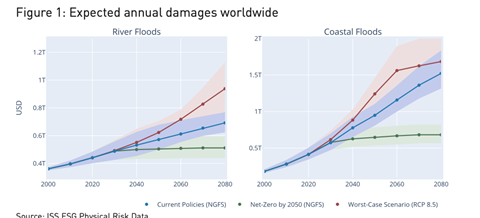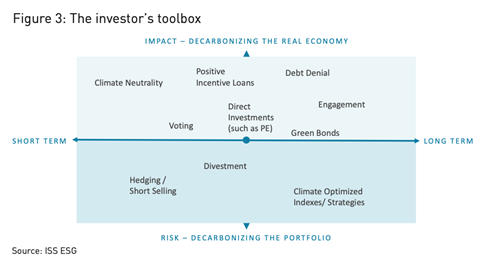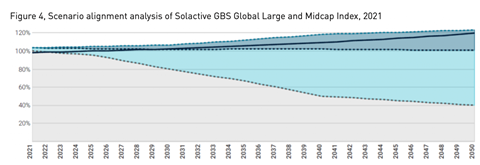Sponsored Commentary from ISS ESG
In the run-up to COP26, Net Zero pledges have become increasingly ubiquitous. Over 100 countries, including China, the U.S. and the EU, have pledged to become Net Zero. Further, over 100 local governments, nearly 1000 cities and 2000 businesses pledged to operate at Net Zero. Net Zero is now also the trillion dollar challenge for investors. The Net Zero Asset Owner Alliance and the Net Zero Investment Framework have embarked to build Net Zero portfolios.
But as investors observe the well-intentioned corporates and sovereigns scramble to publish carbon reduction targets and net zero ambitions, they also need to be aware of the implications of the current lack of action plans and specific reduction roadmaps.
Professed Net Zero investment portfolios face significant pitfalls, as even one of the most high profile climate advocates had to learn the hard way. Mark Carney – former Governor of the Bank of England and midwife to the Task Force on Climate Related Financial Disclosure (TCFD) – was forced to row back after claiming that his new home Brookfield was Net Zero. An outraged group of scientists and NGOs accused him of greenwashing by the use of carbon accounting tricks.
What does achieving ‘Net Zero’ really mean?
To understand why net zero pledges come with a considerable number of strings attached, let’s dive into what achieving Net Zero really means.
Net Zero now replaces “Paris-aligned” as the main focus, reflecting the shift of aiming to limit temperature increase to 1.5°C as opposed to 2°C. As the term itself holds a lot of nuances, it is important to understand the science and concepts behind it. The main goal of the Paris Agreement remains the limiting of the catastrophic impacts of climate change. This goal is tied to rapidly halting global temperature rise. As the IPCC’s 2018 Special Report on 1.5°C stressed, even a 0.5°C difference could lead to devastating outcomes for life on earth. Through the modelling of 1.5°C consistent pathways, the report showed that achieving this goal with a limited or no overshoot would require global CO2 emissions to reach Net Zero by 2050. This means that emissions are reduced to as low as possible, with all remaining unabated emissions removed from the atmosphere.
What Net Zero hence really means is captured in the “NETTING” concept. Net Zero means to not emit any NET emissions anymore at a certain point in the future, with the intention of limiting global warming to 1.5°C versus pre-industrial levels. Yes, Net Zero requires bringing down our emissions as much as possible – much more than current and stated policies require to date. At the same time – and largely overlooked – it also requires investing in taking the remaining greenhouse gas emissions out of the atmosphere by rapidly developing and scaling carbon removal technologies.

Our Net Zero future leans on emission reductions reliant, in parts, on currently non-existent policies such as changes to fossil fuel subsidies, in combination with emission removals relying on currently non-existent technologies. And especially this part of the equation, the sequestration of greenhouse gas emissions, sees very little investor attention.
The clock is ticking – we might be passing 1.5°C by the early 2030s already
The Intergovernmental Panel on Climate Change (IPCC) recently released the first part of the sixth Assessment Report (AR6). This report — the most comprehensive synthesis of climate research to date — will play a pivotal role in developing climate-related policy in the coming years.
The full report is condensed into an accessible 40 page document — the summary for policymakers (SPM), which was approved line-by-line by close to 200 government delegates.
Perhaps not surprisingly, the new AR6 presents the most compelling evidence to date that human activities have caused our planet to warm at an unprecedented rate, resulting in widespread and rapid climate change. The new report strongly confirms the IPCC’s message over the years in what is perhaps the most important and powerful statement yet:
“It is unequivocal that human influence has warmed the atmosphere, ocean, and land.”
So far, the ball is still in our court: the report states that limiting global warming to 1.5C is still possible but requires substantial, rapid, and sustained reductions in greenhouse gas emissions in the 2020s and achieving net zero emissions by 2050. Failure to do so will likely see the world pass the symbolic 1.5C in the early 2030s with significant consequences in terms of impacts as can be seen in Figure 1.
What does it take?
The challenges are known. First: we need to remove 10 gigatons of greenhouse gas emissions by 2050 – more than what the US emits – per year! Second: none of today’s known approaches are able to absorb this amount. Take natural removals, for instance, still the only concrete carbon removal measure taken up by corporate Net Zero pledges: for the Net Zero plan of Shell alone, an afforestation the size of Brazil would be needed.
The Net Zero movement and all the pledges around that is very much a positive development, but once you have a commitment in place, that’s just the starting point—a big concern is that there are a large amount of commitment statements and nowhere near the same level of action plans and transition plans to go along with that. One case in point is the still very low number overall of companies reporting their GHG emissions globally (see Figure 2 below).
Given that there is not yet an established net zero roadmap for businesses to follow—in part because achieving Net Zero by 2050 will require as yet unproven carbon removal technology to work—means companies need to be realistic and transparent about how they intend to meet their targets including about the extent to which companies are relying on future technology as part of their carbon reduction pledges.

Companies need to lay out measures they can apply right now to address their emissions which most likely means improving efficiency in their operations, sources of power supply and the implementation of technologies that are already viable as part of their carbon reduction pledges.
What’s an investor to do?
Financial market participants can efficiently change the course of companies. What is needed, though, is a nuanced, asset class-specific approach that understands the respective dynamics as well as the available instruments in the ‘Investor’s Toolbox’.
Some of the tools at hand are geared towards decarbonising a portfolio (lower part of Figure 3), while others aim to decarbonise the real economy (upper part of Figure 3). For equities, approaches such as divestment and climate-optimised equity strategies can help from a risk management angle. Engagement and proxy voting can change the course of a company, however. On the debt side, not participating in the issuance of bonds or not lending to certain companies due to their ESG performance is an effective means of impacting economic activity and providing cheaper capital to companies that achieve certain ESG targets (for example through positive incentive loans). The finance industry has very good intentions when it comes to solving the climate change challenge. In terms of approaches and execution, however, the nature of financial market mechanics may result in a lot of action without real impact. Only by making use of the entire investor’s toolbox, and by systematically and clearly evaluating the effects of each approach, can investors and regulators alike execute on their respective theories of risk or change.
How ISS ESG supports investors
ISS solutions continue to evolve to support investors navigating these challenges. ISS ESG’s scenario alignment analysis provides valuable insight on portfolios positioning in relation to credible decarbonisation pathways. Portfolio alignment analysis highlights portfolio temperature trajectories exceeding 1.5°C. Granular data is available per issuer, so investors can identify hot spots in their portfolios. As can be seen in Figure 4, a scenario alignment analysis of the Solactive GBS Global Large and Midcap Index, the index is far from net zero. This type of analysis can be used as a springboard for a net zero strategy and throughout the investment process. ISS ESG will be including specific Net Zero solutions by Q1 2022.

With such unprecedented transition opportunities, vast investment in climate solutions is needed, with the IMF and the IEA estimating USD +4tn average annual capital investment by the 2030s in cleantech for the energy sector alone. Whilst many mitigation technologies are available at scale, such as solar PV and EVs, others such as industrial carbon capture and storage (CCS) or Direct Air Capture and Storage are in earlier stages. These varying risk-return profiles call for innovation in the financing space including the valuing of future benefits. Quantifying the positive impact through emissions avoidance or reduction is a helpful tool when developing low-carbon and/or climate-friendly products. ISS ESG’s advisory services and product suite, including our EU Taxonomy and Potential Avoided Emissions solutions, can help investors on this journey across asset classes and strategies.
Leveraging data…
ISS ESG can support investors in identifying the most suitable KPIs, analysis, and data to transition portfolios and set relevant net zero targets in accordance with the net zero financial sector initiatives. ISS ESG’s Net Zero Solutions enables investors to assess whether their investments are aligned with a Net Zero scenario. Its Issuer Level Net Zero Alignment Data can be used to identify positive and negative performing companies against a range of individual climate related metrics, whilst the Net Zero Portfolio Report creates an aggregated view of a portfolio’s readiness for Net Zero, considering current and potential future emissions disclosure performance, fossil fuel exposure, potential future performance, climate mitigating revenue and target setting. ISS ESG’s Net Zero Solutions’ distinct methodology for defining Net Zero alignment assessment is based on companies’ substantiated commitments to achieving Net Zero by 2050, as well as whether they have established interim targets, and have a decarbonization strategy.
Reaching Net Zero has to be underpinned by a credible roadmap of short, medium- and long-term targets in line with the latest science.

…for meaningful action
In order to ensure that decarbonising investment and lending portfolios leads to decarbonisation in the real economy, net zero targets need not only focus on GHG reduction alone. The roadmap must include meaningful voting and engagement with both investees and the public domain as the Net Zero Asset Owner Alliance’s Target Setting Protocol and the Paris-Aligned Initiative’s Net Zero Investment Framework already stress. Active ownership is a key lever in the investors’ toolkit for achieving net zero and many are beginning to use it as we have seen with the recent vote at Exxon Mobil. ISS ESG can help investors define and execute climate-specific voting policies based on the ISS Climate Awareness Scorecard (CAS) and support with net zero engagement requirements with ISS ESG’s Engagement Solutions.
Credibility is gained through disclosure and transparency which are turning into the norm. The UK Government is bringing forward legislation making climate-related financial disclosure mandatory for both corporates and asset owners. At the same time, the United States’ Securities and Exchange Commission is consulting on incorporating climate and ESG information in standard financial disclosures, in alignment with the TCFD sector-specific recommendations. ISS ESG’s Climate Impact Report provides investors with key metrics and analysis supporting TCFD disclosures. For those new to climate-related financial disclosures, ISS ESG’s Bespoke Analytics team offers a full TCFD report writing service.
The same also holds true for sovereign debt. Sovereign debt investors should not just consider public pledges and formal adherence to international agreements like the Paris accord, they should also hold sovereigns to account for their pledges and targets. The ISS ESG Sovereign Climate data set and the ISS ESG Country Rating provide investors with the data they need to analyse the climate risks of their sovereign investments. ISS ESG offers analysis showing the climate transition risks faced by countries regarding emissions, energy use, reserves, and the ratification of international conventions. Using three very different countries as case studies, this paper highlights how country-level analysis can provide a rich insight into the broader ESG risks being managed by sovereign states. Climate change is the clear focus, but investors can also take into account the social and governance context that enables a country’s management of their climate change obligations.
As the United Nation’s Race to Zero campaign nicely puts it, Pledge-Plan-Proceed-and-Publish in order to achieve our goal of limiting catastrophic temperature rise. The task at hand is huge, the stakes are high, and we need all hands on deck. Thus, using all the tools available to investors will be key. Wherever you are on the net zero journey, ISS ESG is able to help.
Viola Lutz - viola.lutz@iss-esg.com




















No comments yet